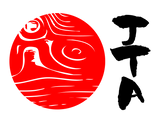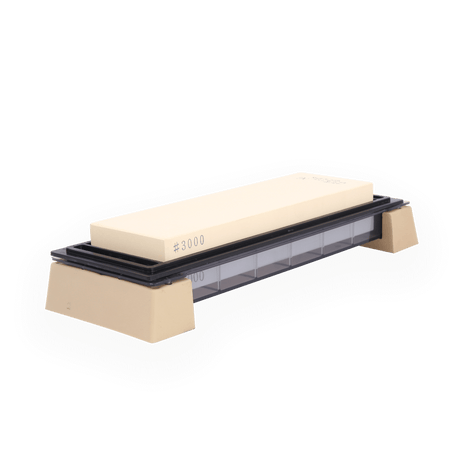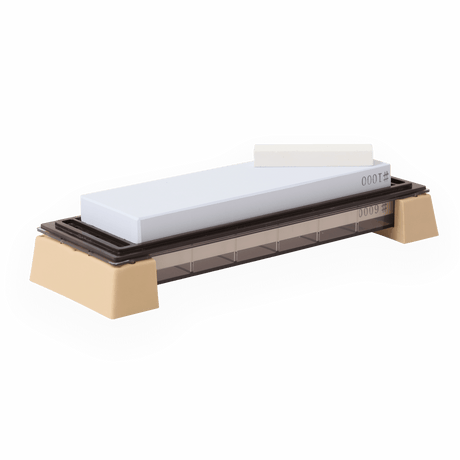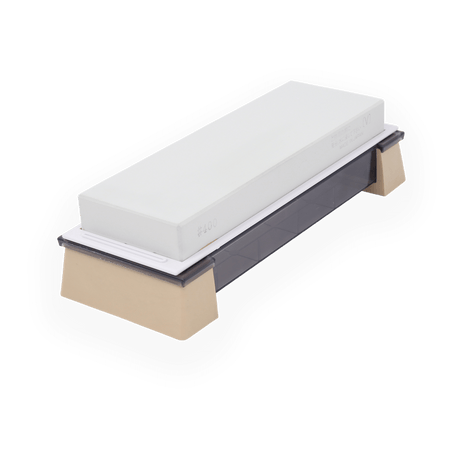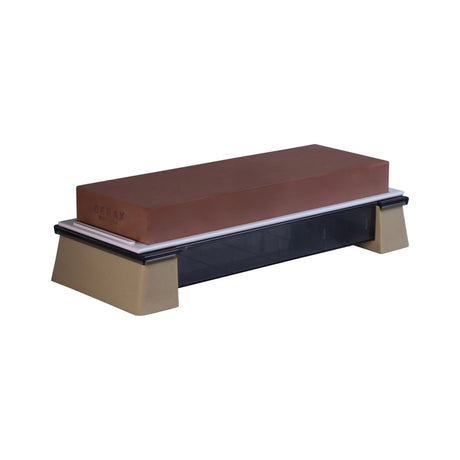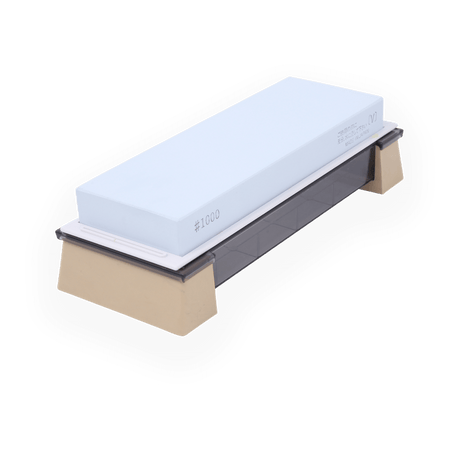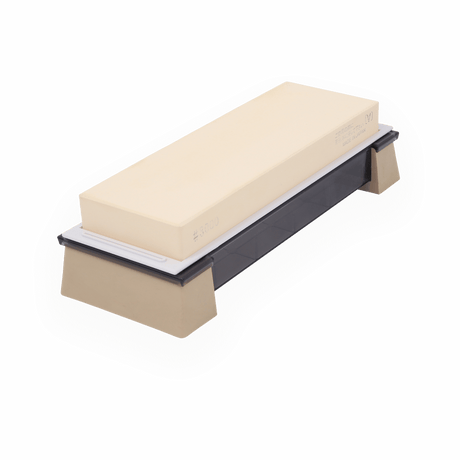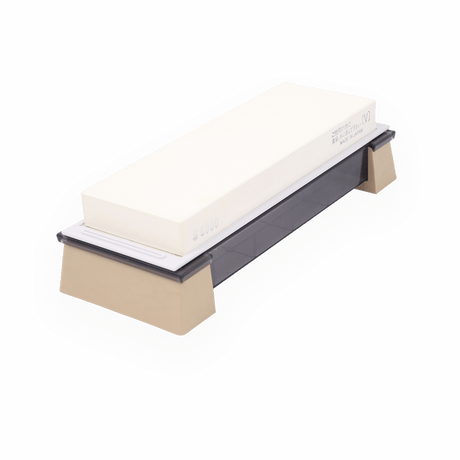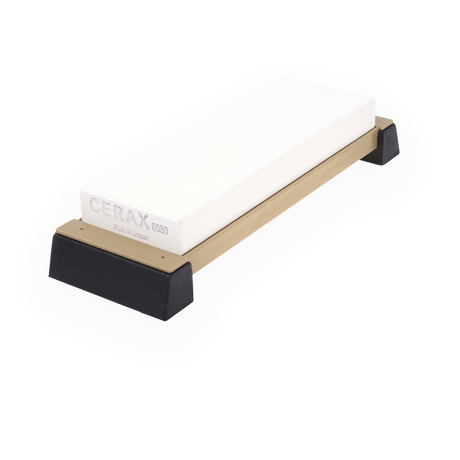Waterstones are our preferred way of sharpening all of our tool and knife edges, however, there is a need to maintain waterstones during and after use in order to get the most from them.
The main difficulty with waterstones is that they wear and dish as edges are passed over them. This is a necessary part of their makeup, as the binder in the stone breaks down to reveal fresh grit.
Some stones break down faster than others, which is a double edged sword. A harder stone will dish slower, but when it comes time to flatten that stone, it will take longer to bring back to flat.
So the best advice we can provide, regardless of the grit or brand of stone you use, is to flatten as often as is possible. The only way to do this is with another known flat surface that needs to be more abrasive than the stone you are flattening.
There are three methods we can suggest for you to use to flatten your stones - glass and sandpaper, diamond plates, and paired waterstones.
Glass and Sandpaper
The cheapest way to flatten waterstones is with sandpaper stuck to or spread across a flat surface, so if you own a sheet of glass and some wet'n'dry, you're in business.
We sell adhesive backed sandpaper sheets and glass sized to match, either to the full sheet, or to take a third of the sheet. This way, you can flatten on the bench or create your own flattening stone.
The tradeoff of this cheap and simple method of flattening is that the sandpaper can clog quite quickly. We find the #180 grit is the best for this job on lower grit stones, and #240 on finer grit stones. When the sandpaper does clog, we brush it down with a hand broom or anything else with relatively thick bristles, and keep on going.
The other drawback of our partucular adhesive sandpaper is that if the paper is flooded or soaked with water, the adhesive lets go and the paper swells out of flat. To use it effectively, flatten while your stone is dry or damp, but not when it is wet.
In summary, glass and sandpaper is a simple and cheap way to keep stones flat, but not the most efficient.
Using Two Paired Waterstones
In the world of Japanese waterstones, there exist so-called dedicated flattening stones for bringing waterstones back to flat. We don't really stock them, on the advice of our teachers who do not use them. The point they make is that the process of flattening must wear out both the waterstone and whatever is being used to flatten it. If a single surface is used, it's flatness must also be managed. We've seen these coarse stones scrubbed on concrete to bring them back to flat, but we can't look our customers in the eye and suggest they use an unkown concrete slab as a reference surface.
The best method we have seen for using waterstones to flatten other waterstones is practiced by Hiroshi Yamaguchi and Ryo Fujimoto, who advocate using two waterstones as a dedicated pair of flattening stones. By alternating between two flattening stones, and flattening them on each other, their reference surfaces can be managed.
An intermediate grit is preferable here, and we'd recommend #800 or #1000 grit stones for this purpose.
When flattening these stones on each other, we recommend flipping them end-to-end a few times to make sure they aren't referencing their own peaks and troughs and making the whole situation worse. It's also worth washing your higher grit waterstones after flattening with these stones, as otherwise you will contaminate your beautiful high grit stones with intermediate slurry.
Diamond Plates
Far and away our preferred method of flattening is with diamond plates. Over the years we've stocked at least three different brands and used them all for flattening, but for the moment at least we are only stocking the Atoma brand.
The Atoma plates come as a 1.5mm diamond-impregnated sheet adhered to an aluminium base, or as a single 1.5mm diamond-impregnated sheet with no substrate and adhesive tape on the back. This is an advantage for a number of reasons.
The first is flatness. A previous manufacturer's plates arrived to us unnacceptably out of flat, and it goes without saying that that it's impossible to flatten a waterstone with a non-flat diamond plate. The aluminium bases of the atoma diamond plates have passed all of our visual tests so far, and if you want to perform your own, a ruler across the plate will give you a pretty good indication of where your plate is at. We're yet to have any issues with the Atoma bases, though we don't think the backs are flat enough to make these into double sided plates.
However, the fact that the Atoma abrasives come without any substrate means that we, and you, can have complete control over the flatness of the base. We have sized float glass to match the Atoma sizing, which will knock a small amount off the price of a full plate, and can be made into a double-grit plate.
We have also started getting our steel lapping plates anufactured to match the Atomas for size as well. If you need a known and measureable tolerance of flatness for your diamond stone, we'd suggest this route. The drawback here is that using the steel as a base makes the whole unit pretty heavy, so it becomes easier to leave the diaond plate on the bench and bring the stone to it.
The Atoma plates come in four different grits - #140, #400, #600 and #1200. We have no hesitation in recommending the #400 as our preferred grit for flattening, closely followed by the #600.
The coarser the grit in the Atomas, the longer lasting they'll be as stone flattening plates. We have put out all grits for busy multi-day classes, and would only recommend the #1200 for flattening the very finest stones - coarse and intermediate stones will wear it out too quickly for it to represent value for money.
The #140, on the other hand, is the hardest wearing diamond plate we've come across from any brand, Japanese or otherwise. While it's great for flattening off coarse waterstones, the scratch pattern it leaves in fine and intermediate stones is quite deep.
For these reasons, we recommend the #400 and #600 as the referred grit for flattening stones. We find the #400 to be hardest wearing, so would recommend that to most customers, though the #600 will do the same job slightly slower.
No matter the grit of the plate you own, our advice is that a gentle pressure during the flattening process is best practice. Heavy pressure and fast passes will wear your diamond plates quicker, and increase the risk of sliding off the edge of the stone and adding a facet.
Make sure to work the stone from both directions and at a number of angles. Flatten lightly and often to keep your stone as close to flat as possible and reduce the amount of time you need to spend flattening.
